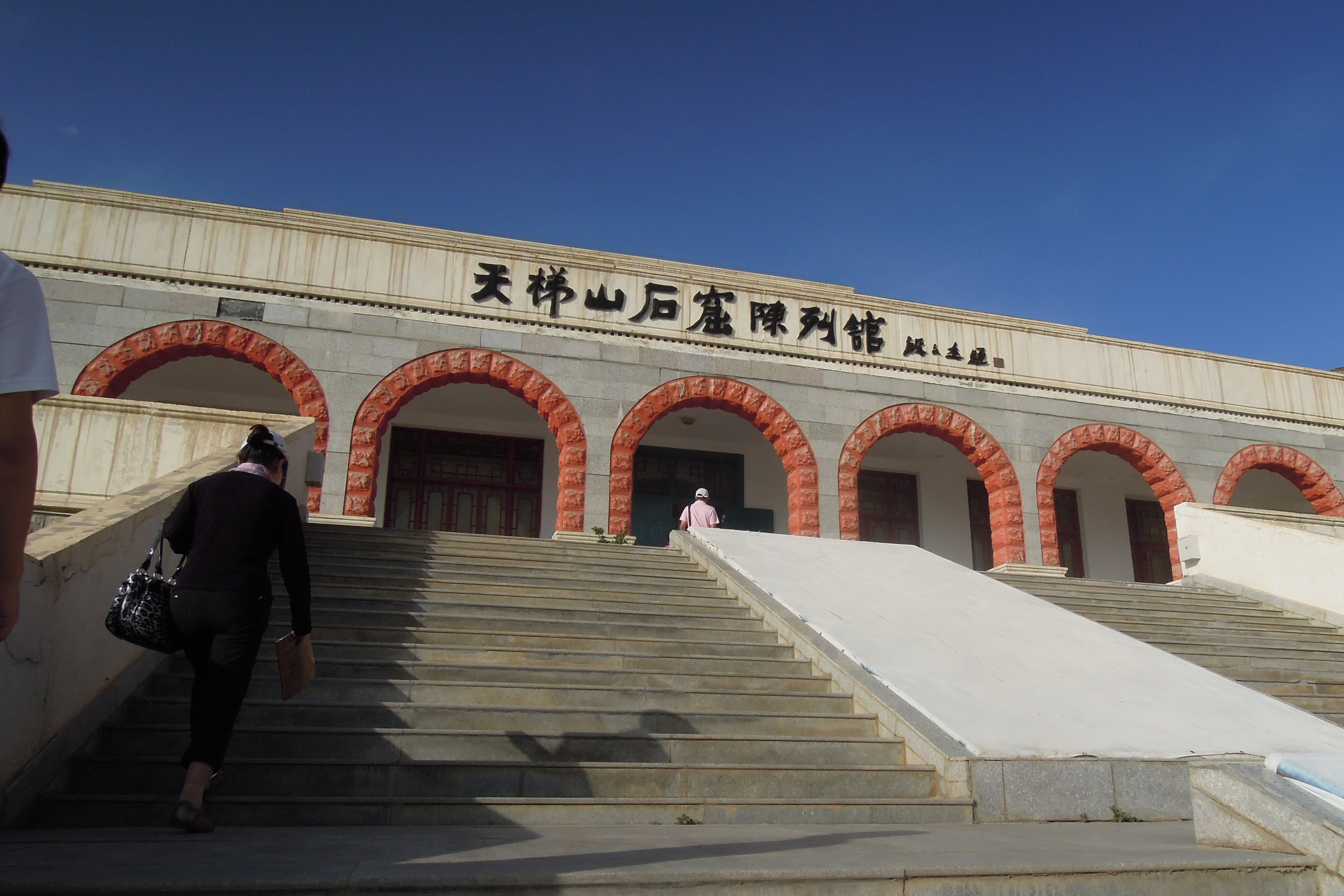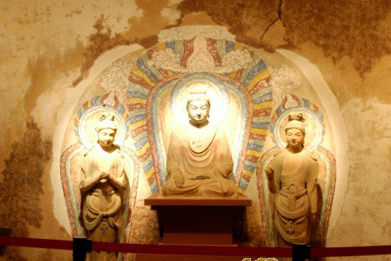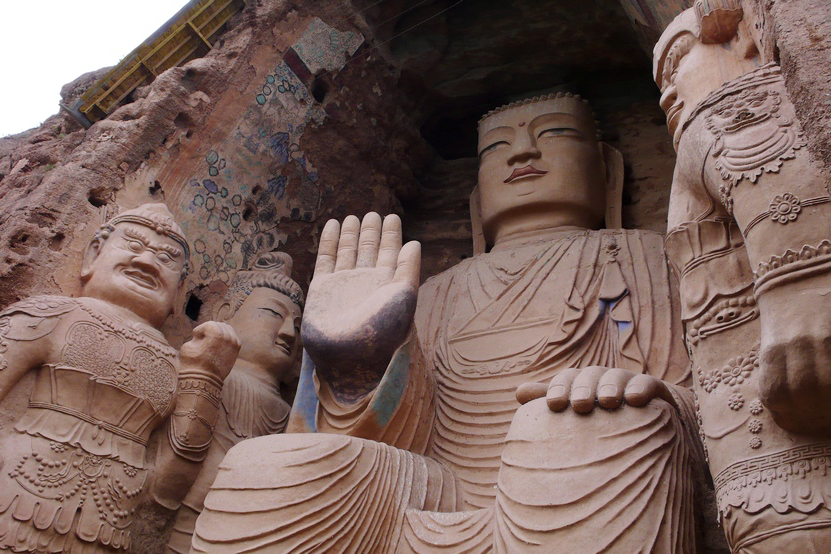Home > Attractions >
Tiantishan Grottoes
As one of the historical travel destinations along the silk road, the Tiantishan Grottoes is situated on the Huangyang River, about 60 km south of Wuwei (originally Liangzhou) and Twere excavated during the Northern Liang dynasty (397–439 CE).
What to visit in Tiantishan Scenic Area?
On the basis of the style, content, and inscriptions on the wall paintings and landforms, archaeologists believe that the Tiantishan grottoes may be the Liangzhou grottoes mentioned in historical documents, such as the Fa Yuan Zhu Lin. According to historical records, the Liangzhou grottoes were ranked with the Yungang and Longmen grottoes as the three major cave temple sites to have exerted a profound influence on the development of Chinese painting and sculpture.
At present, there are only three layers of Tiantishan Grottoes and 17 large and small grottoes, the largest cave is 30 metres high, 19 metres wide and 6 metres deep. When you enter the scenic area, you can see a statue of Sakyamuni in the cave, which is 15 metres high and 10 meters wide. Meanwhile, there are six statues of Manjusri, Puxian Bodhisattva on both sides of the Buddha, Guangmu, Duowen Tianwang, Jiaye, and Ananda, they have vivid shapes, dignity and different images.
The murals of Tiantishan Grottoes:
In addition, when you visiting the grottoes, you will see some large murals painted on the north and south walls of the caves. The south wall is a moiré blue dragon, the middle is an elephant Sika deer, the elephant's back is covered with shining rolls, and the underpart is tigers, trees and flowers. The upper part of the north wall is painted with green dragons, while the middle part is painted with white horses, ink tigers, and Bodhi trees. With the fresh brushwork, bright in colour, tremendous in momentum and vivid image to name just a few, that will definitely glut your eyes.
Other information about Tiantishan Grottoes:
If the Tiantishan and Liangzhou grottoes are actually one and the same, research and protection of this site becomes even more meaningful and important. Because of the construction of the Huangyang River reservoir in 1960, the Gansu People’s Government approved moving the wall paintings and polychrome statues of the grottoes, with the exception of seven statues, to the Gansu Provincial Museum for preservation. In conjunction with the restoration and conservation of the Tiantishan relics, the authors collected and analyzed ninety-six samples from the Northern Liang, Northern Wei, Tang, and Ming dynasties and performed comprehensive analyses of their pigments.
The admission fees: 30 RMB/Person
Opening time: 9.00 AM to 6.00 PM ( Ticket sales are suspended at 5.30 PM )
What to visit in Tiantishan Scenic Area?
On the basis of the style, content, and inscriptions on the wall paintings and landforms, archaeologists believe that the Tiantishan grottoes may be the Liangzhou grottoes mentioned in historical documents, such as the Fa Yuan Zhu Lin. According to historical records, the Liangzhou grottoes were ranked with the Yungang and Longmen grottoes as the three major cave temple sites to have exerted a profound influence on the development of Chinese painting and sculpture.
At present, there are only three layers of Tiantishan Grottoes and 17 large and small grottoes, the largest cave is 30 metres high, 19 metres wide and 6 metres deep. When you enter the scenic area, you can see a statue of Sakyamuni in the cave, which is 15 metres high and 10 meters wide. Meanwhile, there are six statues of Manjusri, Puxian Bodhisattva on both sides of the Buddha, Guangmu, Duowen Tianwang, Jiaye, and Ananda, they have vivid shapes, dignity and different images.
The murals of Tiantishan Grottoes:
In addition, when you visiting the grottoes, you will see some large murals painted on the north and south walls of the caves. The south wall is a moiré blue dragon, the middle is an elephant Sika deer, the elephant's back is covered with shining rolls, and the underpart is tigers, trees and flowers. The upper part of the north wall is painted with green dragons, while the middle part is painted with white horses, ink tigers, and Bodhi trees. With the fresh brushwork, bright in colour, tremendous in momentum and vivid image to name just a few, that will definitely glut your eyes.
Other information about Tiantishan Grottoes:
If the Tiantishan and Liangzhou grottoes are actually one and the same, research and protection of this site becomes even more meaningful and important. Because of the construction of the Huangyang River reservoir in 1960, the Gansu People’s Government approved moving the wall paintings and polychrome statues of the grottoes, with the exception of seven statues, to the Gansu Provincial Museum for preservation. In conjunction with the restoration and conservation of the Tiantishan relics, the authors collected and analyzed ninety-six samples from the Northern Liang, Northern Wei, Tang, and Ming dynasties and performed comprehensive analyses of their pigments.
The admission fees: 30 RMB/Person
Opening time: 9.00 AM to 6.00 PM ( Ticket sales are suspended at 5.30 PM )






